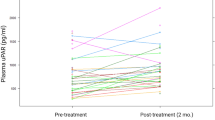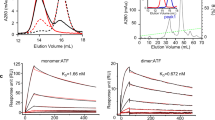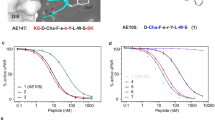Abstract
Using a previously developed enzyme-linked immunosorbent assay (ELISA), the levels of the receptor for urokinase-type plasminogen activator (uPAR) were determined in cytosols and corresponding membrane pellets derived from 878 primary breast tumours. The levels of uPAR in the pellet extracts were more than 3-fold higher than those measured in the cytosols (P< 0.001). Moreover, the uPAR levels in the two types of extracts were weakly, though significantly, correlated with each other (rS= 0.20, P< 0.001). In Cox univariate analysis, high cytosolic levels of uPAR were significantly associated with reduced overall survival (OS) and relapse-free survival (RFS). The levels of uPAR in pellet extracts appeared not to be related with patient survival. In multivariate analysis, elevated levels of uPAR measured in cytosols and pellet extracts were found to be independent predictors of poor OS, not RFS. The prediction of poor prognosis on the basis of high uPAR levels emphasizes its important role in plasmin-mediated degradation of extracellular matrix proteins during cancer invasion and metastasis. © 2001 Cancer Research Campaign http://www.bjcancer.com
Similar content being viewed by others
Article PDF
Change history
16 November 2011
This paper was modified 12 months after initial publication to switch to Creative Commons licence terms, as noted at publication
References
Andreasen PA, Georg B, Lund LR, Riccio A and Stacey SN (1990) Plasminogen activator inhibitors: hormonally regulated serpins. Mol Cell Endocrinol 68: 1–19
Andreasen PA, Kjøller L, Christensen L and Duffy MJ (1997) The urokinase-type plasminogen activator system in cancer metastasis: a review. Int J Cancer 72: 1–22
Behrendt N, Rønne E and Danø K (1995) The structure and function of the urokinase receptor, a membrane protein governing plasminogen activation on the cell surface. Biol Chem Hoppe-Seyler 376: 269–279
Behrendt N, Rønne E and Danø K (1996) Domain interplay in the urokinase receptor; requirement for the third domain in high affinity ligand binding and demonstration of ligand contact sites in distinct receptor domains. J Biol Chem 271: 22885–22894
Bouchet C, Hacène K, Martib PM, Becette V, Tubiana-Hulin M, Lasry S, Oglobine J and Spyratos F (1999) Dissemination risk index based on plasminogen activator system components in primary breast cancer. J Clin Oncol 17: 3048–3057
Bradford MM (1976) A rapid and sensitive method for the quantitation of microgram quantities of protein utilizing the principle of protein-dye binding. Anal Biochem 72: 248–254
Chapman HA (1997) Plasminogen activators, integrins, and the coordinated regulation of cell adhesion and migration. Current Opinion Cell Biol 9: 714–724
Danø K, Behrendt N, Brünner N, Ellis V, Ploug M and Pyke C (1984) The urokinase receptor: protein structure and role in plasminogen activation and cancer invasion. Fibrinolysis 8: 189–203
Danø K, Andreasen PA, Grøndahl-Hansen J, Kristensen P, Nielsen LS and Skriver L (1985) Plasminogen activators, tissue degradation, and cancer. Adv Cancer Res 44: 139–266
De Witte H, Pappot H, Brünner N, Grøndahl-Hansen J, Høyer-Hansen G, Behrendt N, Guldhammer-Skov B, Sweep F, Benraad Th and Danø K (1997) ELISA for complexes between urokinase-type plasminogen activator and its receptor in lung cancer tissue extracts. Int J Cancer 72: 416–423
De Witte JH, Sweep CGJ, Klijn JGM, Grebenschikov NI, Peters HA, Look MP, Van Tienoven Th, Heuvel JJTM, Van Putten WLJ, Benraad ThJ and Foekens JA (1999a) Prognostic impact of urokinase-type plasminogen activator (uPA) and its inhibitor (PAI-1) in cytosols and pellet extracts derived from 892 breast cancer patients. Br J Cancer 79: (7/8): 1190–1198
De Witte JH, Sweep CGJ, Klijn JGM, Grebenschikov N, Peters HA, Look MP, Van Tienoven ThH, Heuvel JJTM, Bolt-De Vries J, Benraad ThJ and Foekens JA (1999b) Prognostic value of tissue-type plasminogen activator (tPA) and its complex with the type-1 inhibitor (PAI-1) in breast cancer. Br J Cancer 80: 286–294
Duffy MJ (1992) The role of proteolytic enzymes in cancer invasion and metastasis. Clin Exp Metastasis 10: 145–155
Duffy MJ (1996) Proteases as prognostic markers in cancer. Clin Cancer Res 2: 613–618
Duggan C, Maguire T, McDermott E, O’Higgins N, Fennelly JJ and Duffy MJ (1995) Urokinase plasminogen activator and urokinase plasminogen activator receptor in breast cancer. Int J Cancer 61: 597–600
Ellis V, Behrendt N and Danø K (1991) Plasminogen activation by receptor-bound urokinase; a kinetic study with both cell-associated and isolated receptor. J Biol Chem 266: 12752–12758
E.O.R.T.C. Breast Cancer Co-operative Group (1980) Revision of the standards for the assessment of hormone receptors in human breast cancer; report of the second E.O.R.T.C. workshop, held on 16–17 March, 1979, in The Netherlands Cancer Institute. Eur J Cancer 16: 1513–1515
Foekens JA, Portengen H, Van Putten WLJ, Peters HA, Krijnen HLJM, Alexieva-Figusch J and Klijn JGM (1989) Prognostic value of estrogen and progesterone receptors measured by enzyme immunoassays in human breast tumor cytosols. Cancer Res 49: 5823–5828
Foekens JA, Peters HA, Look MP, Portengen H, Schmitt M, Kramer MD, Brünner N, Jänicke F, Meijer-van Gelder M, Henzen-Logmans SC, van Putten WLJ and Klijn JGM (2000) The urokinase system of plasminogen activation and prognosis in 2780 breast cancer patients. Cancer Res 60: 636–643
Grøndahl-Hansen J, Peters HA, Van Putten WLJ, Look MP, Pappot H, Rønne E, Danø K, Klijn JGM, Brünner N and Foekens JA (1995) Prognostic significance of the receptor for urokinase plasminogen activator in breast cancer. Clin Cancer Res 1: 1079–1087
Kanse SM, Kost C, Wilhelm OG, Andreasen PA and Preissner KT (1996) The urokinase receptor is a major vitronectin-binding protein on endothelial cells. Exp Cell Res 224: 344–353
Kaplan EL and Meier P (1958) Nonparametric estimation from incomplete observation. J Am Stat Assoc 53: 457–481
Kristensen P, Eriksen J, Blasi F and Danø K (1991) Two alternatively spliced mouse urokinase receptor messenger RNAs with different histological localization in the gastrointestinal tract. J Cell Biol 115: 1763–1771
Liotta LA, Thorgeirsson UP and Garbisa S (1982) Role of collagenases in tumor cell invasion. Cancer Metastasis Rev 1: 277–288
Look MP and Foekens JA (1999) Clinical relevance of the urokinase plasminogen activator system in breast cancer. APMIS 107 (1:150–159
Mignatti P and Rifkin DB (1993) Biology and biochemistry of proteinases in tumour invasion. Physiol Rev 73: 161–195
Pappot H, Høyer-Hansen G, Rønne E, Hansen HH, Brünner N, Danø K and Grøndahl-Hansen J (1997) Elevated plasma levels of urokinase plasminogen activator receptor in non-small cell lung cancer patients. Eur J Cancer 33: 867–872
Ploug M, Rønne E, Behrendt N, Jensen AL, Blasi F and Danø K (1991) Cellular receptor for urokinase plasminogen activator; carboxyl-terminal processing and membrane anchoring by glycosyl-phosphatidylinositol. J Biol Chem 266: 1926–1933
Ploug M, Eriksen J, Plesner T, Hansen NE and Danø K (1992) A soluble form of the glycolipid-anchored receptor for urokinase-type plasminogen activator is secreted from peripheral blood leukocytes from patients with paroxysmal nocturnal hemoglobinuria. Eur J Biochem 208: 397–404
Pyke C, Eriksen J, Solberg H, Nielsen BS, Kristensen P, Lund LR and Danø K (1993) An alternatively spliced variant of mRNA for the human receptor for urokinase plasminogen activator. FEBS Lett 326: 69–74
Rønne E, Behrendt N, Ploug M, Nielsen HJ, Wöllisch E, Weidle U, Danø K and Høyer-Hansen G (1994) Quantitation of the receptor for urokinase plasminogen activator by enzyme-linked immunosorbent assay. J Immunol Methods 167: 91–101
Rønne E, Høyer-Hansen G, Brünner N, Pedersen H, Rank F, Osborne CK, Clark GM, Danø K and Grøndahl-Hansen J (1995) Urokinase receptor in breast cancer tissue extracts; enzyme-linked immunosorbent assay with a combination of mono- and polyclonal antibodies. Breast Cancer Res Treat 33: 199–207
Schmitt M, Harbeck N, Thomssen C, Wilhelm O, Magdolen V, Reuning U, Ulm K, Höfler H, Jänicke F and Graeff H (1997) Clinical impact of the plasminogen activation system in tumor invasion and metastasis: prognostic relevance and target for therapy. Thromb Haemost 78: 285–296
Sier CF, Stephens R, Bizik J, Mariani A, Bassan M, Pedersen N, Frigerio L, Ferrari A, Dano K, Brunner N and Blasi F (1998) The level of urokinase-type plasminogen activator receptor is increased in serum of ovarian cancer patients. Cancer Res 58: 1843–1849
Stephens RW, Pedersen AN, Nielsen HJ, Hamers MJAG, Høyer-Hansen G, Rønne E, Dybkjær E, Danø K and Brünner N (1997) ELISA determination of soluble urokinase receptor in blood from healthy donors and cancer patients. Clin Chem 43: 1868–1876
Stephens RW, Nielsen HJ, Christensen IJ, Thorlacius-Ussing O, Sorensen S, Danø K and Brünner N (1999) Plasma urokinase receptor levels in patients with colorectal cancer: relationship to prognosis. J Natl Cancer Inst 91 ( 10): 869–874
Waltz DA and Chapman HA (1994) Reversible cellular adhesion to vitronectin linked to urokinase receptor occupancy. J Biol Chem 269: 14746–14750
Wei Y, Waltz DA, Rao N, Drummond RJ, Rosenberg S and Chapman HA (1994) Identification of the urokinase receptor as an adhesion receptor for vitronectin. J Biol Chem 269: 32380–32388
Wei Y, Lukashev M, Simon DI, Bodary SC, Rosenberg S, Doyle MV and Chapman HA (1996) Regulation of integrin function by the urokinase receptor. Science 273: 1551–1555
Author information
Authors and Affiliations
Rights and permissions
From twelve months after its original publication, this work is licensed under the Creative Commons Attribution-NonCommercial-Share Alike 3.0 Unported License. To view a copy of this license, visit http://creativecommons.org/licenses/by-nc-sa/3.0/
About this article
Cite this article
Witte, J., Foekens, J., Brünner, N. et al. Prognostic impact of urokinase-type plasminogen activator receptor (uPAR) in cytosols and pellet extracts derived from primary breast tumours. Br J Cancer 85, 85–92 (2001). https://doi.org/10.1054/bjoc.2001.1867
Received:
Revised:
Accepted:
Published:
Issue date:
DOI: https://doi.org/10.1054/bjoc.2001.1867
This article is cited by
-
PET imaging of urokinase-type plasminogen activator receptor (uPAR) in prostate cancer: current status and future perspectives
Clinical and Translational Imaging (2016)
-
Diagnostic and prognostic significance of CA IX and suPAR in gastric cancer
Medical Oncology (2013)
-
Urokinase receptor splice variant uPAR-del4/5-associated gene expression in breast cancer: identification of rab31 as an independent prognostic factor
Breast Cancer Research and Treatment (2008)



